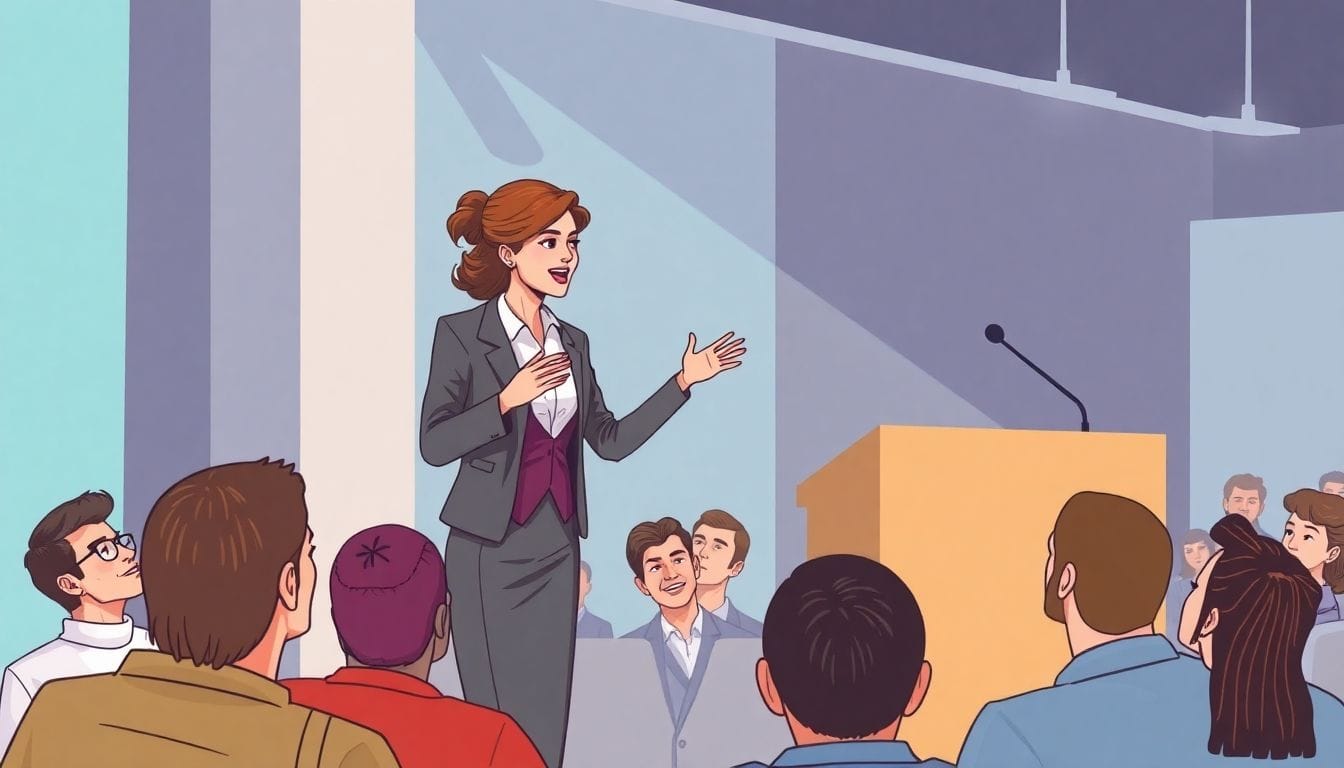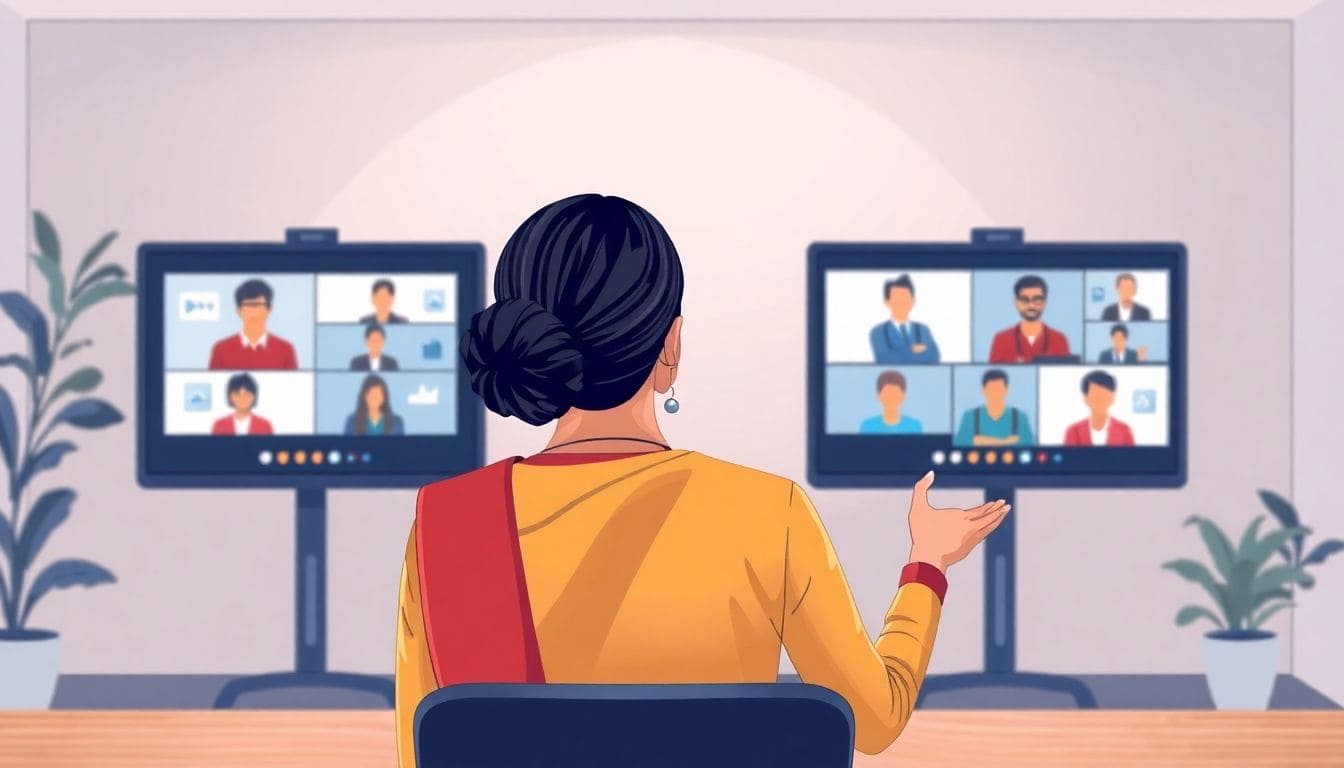Public speaking skills are essential for effective communication and making an impact. Whether presenting at a conference, leading a meeting, or speaking to a small group, clear expression of ideas boosts confidence and credibility. This article covers strategies to enhance your public speaking skills, including managing anxiety, engaging your audience, and using body language effectively. Let’s dive into becoming a more powerful speaker!
Key Takeaways
- Know your audience to tailor your message effectively.
- Practice regularly to build confidence and reduce anxiety.
- Use storytelling to make your presentations more engaging.
- Incorporate body language and eye contact to connect with your audience.
- Seek feedback to continuously improve your public speaking skills.
Mastering The Art Of Public Speaking
Understanding Your Audience
Knowing your audience is more than just knowing demographics. It’s about understanding their needs, expectations, and what they hope to gain from your presentation. Tailoring your message to resonate with them is key. Think about what keeps them up at night, what problems they face, and how your talk can provide solutions or insights. This connection will make your words far more impactful.
Before you even think about your slides, spend time researching your audience. What are their interests? What are their biases? What language do they use? The more you know, the better you can connect.
As a keynote speaker, I will send the client/company/conference a needs assesment to ensure that I understand their objectives and expectations. This assessment will help me tailor my presentation to meet their specific needs and deliver maximum value. While I used to do this informally, Les Brown (yes, that Les Brown) spoke to our local Georgia chapter of National Speakers Association and walked through how he has used it over the decades. That insight has me take a few minutes to think about the audience needs for even more informal settings, like before giving a presentation at a Board meeting for my company.
Crafting Your Message
Your message is the heart of your presentation. It should be clear, concise, and compelling. Don’t try to cram too much information into one talk. Instead, focus on a few key points that you can deliver effectively. Think about the takeaway – what do you want your audience to remember long after you’ve finished speaking? Make sure every element of your presentation supports that central message. Effective communication skills are essential for conveying your message clearly.
The Importance Of Storytelling
People connect with stories. Storytelling in public speaking isn’t just about entertainment; it’s about making your message memorable and relatable. A well-crafted story can illustrate a point, evoke emotion, and create a lasting impression. Think about how you can weave personal anecdotes, case studies, or even fictional narratives into your presentation to bring your ideas to life. Learning how to be a great public speaker often involves mastering the art of storytelling.
Stories are powerful tools. They can make complex ideas easier to understand, and they can create an emotional connection with your audience. Don’t be afraid to share your own experiences – vulnerability can be incredibly engaging.
Building Confidence Through Practice
Confidence in public speaking isn’t some magical gift; it’s built, brick by brick, through consistent effort. Think of it like learning to ride a bike – you wobble, you fall, but you keep getting back on until you’re cruising. Public speaking is the same. The more you do it, the more comfortable and confident you’ll become. It’s about putting in the reps, just like at the gym.
Embrace Opportunities To Speak
Seriously, say “yes” more often. Volunteer to present at work, offer to speak at community events, or even just raise your hand more in meetings. Every time you speak, you’re building your confidence muscle. It doesn’t matter if it’s a small group or a large audience; the experience is what counts. Look for chances to share your ideas, even if it feels scary. Each opportunity is a step forward.
Join Public Speaking Groups
Groups like Toastmasters are goldmines for aspiring speakers. You’ll find a supportive environment where you can practice, get feedback, and learn from others. It’s a safe space to make mistakes and grow. Plus, you’ll meet people who understand what you’re going through, which can be incredibly encouraging. Don’t underestimate the power of community in building confidence.
Practice In Front Of Friends
Grab a few friends or family members and ask them to be your audience. It’s less intimidating than a room full of strangers, and you can get honest feedback from people you trust. Record yourself and watch it back. It might be cringy, but it’s a great way to identify areas for improvement.
Remember, practice doesn’t make perfect, but it makes permanent. The more you rehearse, the more natural and confident you’ll feel when you’re on stage. It’s about ingraining the material and your delivery so that you can focus on connecting with your audience, not just remembering what to say.
Confidence isn’t about eliminating fear; it’s about managing it. And the best way to manage fear is to face it head-on, again and again, until it loses its power over you.
Overcoming Public Speaking Anxiety

Public speaking anxiety, or stage fright, is super common. It’s that feeling of dread, the sweaty palms, the racing heart – yeah, we’ve all been there. But guess what? It’s totally manageable. You don’t have to let anxiety hold you back from sharing your awesome ideas with the world. Let’s dive into some practical ways to kick that anxiety to the curb.
Identifying Your Fears
First things first, let’s figure out what exactly you’re afraid of. Is it the fear of messing up? Of being judged? Of forgetting what you want to say? Write it all down. Knowing your specific fears is the first step to conquering them. Once you know what you’re up against, you can start to develop strategies to deal with those specific anxieties. For example, if you’re worried about forgetting your speech, practice it more, or have notes handy. If you’re worried about being judged, remind yourself that most people are supportive and want you to succeed.
Techniques To Calm Nerves
Okay, so you know your fears. Now, let’s talk about some techniques to calm those nerves when they start to bubble up. Deep breathing is a game-changer. Before you go on stage, take a few slow, deep breaths. Inhale deeply, hold for a few seconds, and exhale slowly. This approach can be effective in calming nerves. It helps to slow your heart rate and calm your mind. Another trick? Visualize success. Imagine yourself giving a killer presentation, feeling confident and connecting with your audience. The more you visualize it, the more confident you’ll feel when you actually do it. For those of you who are public speaking tips for introverts or even public speaking tips for ambiverts, remember that preparation is your superpower. The more prepared you are, the less anxious you’ll feel.
Visualizing Success
Visualizing success is more than just daydreaming. It’s about creating a mental movie of you absolutely crushing it on stage. See yourself speaking clearly, confidently, and engagingly. Imagine the audience nodding along, laughing at your jokes, and being genuinely interested in what you have to say. Really feel the positive emotions associated with success – the pride, the excitement, the sense of accomplishment. The more vivid and detailed your visualization, the more powerful it will be. This technique is especially helpful for how to handle stage fright. It’s like training your brain to expect success, which can significantly reduce anxiety when the real moment arrives.
It’s important to remember that everyone experiences anxiety differently. What works for one person might not work for another. The key is to experiment with different techniques and find what works best for you. Don’t be afraid to try new things and don’t get discouraged if something doesn’t work right away. Keep practicing and keep experimenting, and eventually, you’ll find the strategies that help you manage your anxiety and deliver powerful presentations.
Engaging Your Audience Effectively

Alright, let’s talk about engaging an audience. It’s not just about talking at people; it’s about connecting with them. Think of it as a conversation, not a lecture. If you don’t engage them, they’ll tune you out faster than you can say “PowerPoint”.
Using Eye Contact
Eye contact is your secret weapon. Don’t just stare blankly; make genuine connections. Scan the room, make brief eye contact with individuals, and make them feel seen. It’s like saying, “Hey, I see you, and I’m talking to you.”
Incorporating Humor
Humor can be a game-changer, but tread carefully. Self-deprecating humor often works well. Don’t force it; if you’re not funny, don’t try to be a comedian. A well-placed, relevant joke can wake up a drowsy audience and make you more relatable.
Encouraging Audience Interaction
Don’t be afraid to get the audience involved. Ask questions, run polls, or even have them do a quick activity. Managing audience Q&A sessions effectively is key. Set ground rules, keep answers concise, and don’t be afraid to say, “I don’t know, but I’ll find out.”
Remember, a presentation is a two-way street. The more you involve your audience, the more engaged they’ll be, and the more impactful your message will become. It’s about creating a shared experience, not just delivering information.
Utilizing Body Language To Enhance Delivery
Body language? It’s not just an add-on; it’s the language. It’s how you tell people you mean business, even before you open your mouth. Think of it as the silent soundtrack to your speech. Nail it, and you’re golden. Flub it, and you might as well be talking to a wall. Let’s get into how to make your body work for you, not against you.
Posture And Presence
Stand tall, my friend. Seriously, it’s the easiest win you’ll get. Shoulders back, chin up (but not too high, nobody likes a snob), and feet planted. It’s not about looking like a soldier; it’s about owning the space. Good posture isn’t just about appearances; it’s about how you feel. When you stand tall, you feel more confident, and that confidence radiates outward. It’s a self-fulfilling prophecy of awesome. Think of it as your personal power stance, ready to take on the world, or at least, your presentation.
Gestures That Connect
Gestures are your secret weapon. They add emphasis, illustrate points, and keep your audience engaged. But here’s the catch: they have to be natural. No robot arms allowed. Use your hands to paint a picture, to show scale, to express emotion. If you’re talking about growth, gesture upwards. If you’re discussing a problem, bring your hands together as if you’re wrestling with it. The key is to make your gestures match your words. Don’t overdo it, though. A few well-placed gestures are way more effective than a constant flurry of activity. Think of yourself as a conductor, guiding the orchestra of your audience’s attention.
Facial Expressions Matter
Your face? It’s a billboard. It’s broadcasting your thoughts and feelings whether you like it or not. So, make sure it’s saying the right things. Smile when appropriate, show empathy when needed, and let your expressions reflect the content of your speech. The worst thing you can do is have a monotone face while talking about something exciting. It’s a disconnect that your audience will pick up on immediately. Practice in front of a mirror, record yourself, and get feedback. Make sure your face is telling the same story as your words. It’s the ultimate form of authenticity, and people connect with that on a deep level.
Body language is a conversation happening whether you intend it or not. Make sure you’re saying what you mean to say, even when you’re not speaking.
Structuring Your Presentation For Impact
Alright, let’s talk about structuring a speech that actually sticks with your audience. It’s not just about throwing information at them; it’s about crafting an experience. Think of yourself as a storyteller, guiding them through a journey.
Creating A Strong Opening
Your opening is your handshake—make it count. Don’t start with a boring introduction like, “Hi, I’m here to talk about…” Instead, grab their attention immediately. Use a surprising statistic, a thought-provoking question, or a brief, engaging story. Think about crafting compelling opening statements that make people sit up and listen. You want them hooked from the first few seconds.
Organizing Main Points
Once you’ve got their attention, keep it by organizing your main points logically. Don’t jump around randomly; create a clear, easy-to-follow structure. A good rule of thumb is the “rule of three” – people tend to remember things better when they’re presented in groups of three. Use headings, subheadings, and transitions to guide your audience through your presentation. This is one of the most important effective presentation techniques.
Crafting A Memorable Conclusion
Your conclusion is your last chance to leave a lasting impression. Don’t just fade out; end with a bang. Summarize your main points, reiterate your key message, and leave your audience with a call to action. Make it clear what you want them to do or think after hearing your presentation. This is where you really drive home how to speak with clarity and impact.
Think of your presentation as a well-structured argument. Each point should build upon the previous one, leading to a clear and compelling conclusion. Don’t leave your audience wondering what the point was; make it crystal clear.
For those in leadership positions, mastering presentation skills for executives is essential. It’s about more than just speaking; it’s about leading and inspiring.
Using Visual Aids To Support Your Message

Visual aids can be a game-changer. They’re not just pretty pictures; they’re tools to help your audience understand and remember your message. But, like any tool, they can be misused. Let’s talk about how to use them right.
Choosing The Right Visuals
Think about your audience. What will resonate with them? A chart? A photo? A short video? The key is relevance. Don’t just throw in visuals for the sake of it. They need to directly support what you’re saying. A good visual can clarify a complex point, evoke emotion, or simply keep people engaged. But a bad one? It’s just a distraction.
Integrating Slides Seamlessly
Your slides should be a support, not the main event. I’ve seen so many presentations where the speaker is just reading off the slides. Don’t be that person! Use your slides as prompts, as visual cues for your audience. Make sure your slides are clean, easy to read, and visually appealing. And for goodness’ sake, don’t cram too much information onto one slide. Less is more, always.
Avoiding Over-Reliance On Aids
Visual aids are great, but you are the star of the show. Don’t let your presentation become a slideshow with a voiceover. Your audience came to hear you, not to watch a screen. Practice your presentation without the slides first. Know your material inside and out. That way, if the technology fails (and it will, eventually), you can still deliver a killer presentation.
Think of your visual aids as spices in a dish. A little can enhance the flavor, but too much can ruin the whole thing. Use them sparingly and intentionally, and you’ll create a presentation that’s both informative and engaging.
Improving Vocal Delivery Techniques
Let’s talk about your voice. It’s not just what you say, but how you say it. Think of your voice as an instrument – you need to tune it to get the best sound. It’s about more than just being loud; it’s about being effective.
Modulating Your Voice
Voice modulation is key to keeping your audience engaged. It’s about varying your pitch, tone, and volume to add color to your speech. Don’t be monotone! Think of it like music – a song with only one note would be pretty boring, right? Try recording yourself and experimenting with different inflections. It might feel weird at first, but it’ll make a huge difference in how your message is received. vocal presence is important.
Pacing And Pausing
Pacing is all about speed. Are you rushing through your presentation like you’re trying to win a race? Or are you dragging on and on, losing your audience’s attention? Find a comfortable speed that allows people to follow along without feeling overwhelmed. Pauses are just as important. Don’t be afraid to take a breath and let your words sink in. A well-placed pause can add emphasis and give your audience a chance to process what you’ve said.
Think of pauses as punctuation marks in your speech. They give your audience a chance to breathe and reflect on what you’ve said. Use them strategically to emphasize key points and create a more engaging experience.
Eliminating Filler Words
Ugh, filler words. “Um,” “ah,” “like,” “you know” – we all use them, but they can really detract from your message. They make you sound unsure of yourself and can be distracting for your audience. The first step is to become aware of when you’re using them. Try recording yourself speaking and listen back. Once you know your trigger words, you can start to consciously eliminate them. It takes practice, but it’s worth it. effective speech delivery techniques are important.
Receiving And Implementing Feedback
Alright, so you’ve just given a presentation. You’re probably thinking, “Phew, glad that’s over!” But hold on a sec. The real growth happens after the applause dies down. It’s all about what you do with the feedback you get. Or, more importantly, what you seek out.
Seeking Constructive Criticism
Don’t just wait for people to pat you on the back. Actively ask for feedback. And not just from your mom who thinks everything you do is amazing. Find people who will give you the straight goods. Colleagues, mentors, even that one brutally honest friend. Ask specific questions. Instead of “How was it?” try “Did the opening grab your attention?” or “Was the data clear?” The more specific your questions, the more useful the feedback will be.
Self-Recording For Review
This one can be tough, but trust me, it’s worth it. Record yourself presenting. I know, I know, nobody likes the sound of their own voice. But watching yourself is like having a mirror to your speaking style. You’ll catch things you never noticed before – fidgeting, filler words, weird facial expressions. It’s all gold, Jerry, gold! I find it helpful to watch without sound the first time, focusing solely on body language. Then, watch again with sound to analyze vocal delivery. It’s a process, but it’s a game-changer.
Learning From Each Experience
Every presentation, whether it’s a roaring success or a total flop, is a learning opportunity. Don’t beat yourself up over mistakes. Instead, analyze what went wrong and why. Did you lose the audience’s attention? Maybe the topic was too complex, or your delivery was too monotone. Did you nail the ending? Great! Figure out what made it work and replicate it next time. Treat each speaking engagement as an experiment, and you’ll be amazed at how quickly you improve.
Think of feedback as a gift, even when it stings a little. It’s a chance to see yourself as others see you, and to become the speaker you’re meant to be. Embrace the process, stay curious, and never stop learning.
The Power Of Authenticity In Speaking

Authenticity? It’s not just a buzzword; it’s the secret sauce that transforms a good presentation into an unforgettable experience. People connect with realness. They can spot a fake a mile away, and trust me, they’ll tune out faster than you can say “PowerPoint.”
Being Yourself On Stage
Forget trying to be someone you’re not. The most captivating speakers are those who embrace their true selves. Let your personality shine through. Don’t try to imitate someone else’s style or delivery. Your unique perspective and quirks are what make you, well, you! It’s okay to be a little weird, a little awkward, or a little quirky. That’s what makes you memorable.
Sharing Personal Stories
Stories are powerful. But personal stories? They’re gold. Sharing your own experiences, struggles, and triumphs creates an instant connection with your audience. It shows them you’re human, relatable, and that you’ve walked the walk. Don’t be afraid to get vulnerable and share something meaningful from your own life. It’s in those moments of vulnerability that true connection happens.
Connecting Through Vulnerability
Vulnerability isn’t weakness; it’s strength. It’s about being willing to show your imperfections, your doubts, and your fears. When you’re vulnerable, you create a space for others to be vulnerable too. It’s in that shared vulnerability that trust is built, and public speaking anxiety melts away. It’s about letting your audience see the real you, flaws and all.
Authenticity isn’t about perfection; it’s about connection. It’s about being real, being honest, and being yourself. When you speak from the heart, you’ll not only captivate your audience, but you’ll also inspire them to be their authentic selves too.
Leveraging Technology For Presentations
Using Presentation Software Effectively
Okay, let’s be real. We’ve all sat through presentations where the slides were, well, painful. Presentation software is a tool, not a crutch. Think of it like this: you’re the chef, and the software is just a really fancy knife. You still need to know what you’re doing. Don’t just throw every bell and whistle you can find onto a slide. Keep it simple, keep it clean, and make sure it actually adds something to what you’re saying. PowerPoint, Keynote, Google Slides – they’re all fine. Pick one and get good at it. But remember, the software is there to support you, not the other way around.
Presentation software should be used to enhance your message, not distract from it. Think of your slides as visual cues, not the script for your speech.
Engaging Online Audiences
Virtual presentations are a whole different ballgame, aren’t they? You’re not just competing with other speakers; you’re competing with email, social media, and that pile of laundry that’s been staring at them all day. Keep it interactive. Use polls, Q&A sessions, and even breakout rooms to keep people involved. Make sure your lighting is good, your audio is clear, and for goodness’ sake, look at the camera! It’s the closest thing you have to eye contact in the virtual world. And don’t be afraid to show some personality. People connect with people, even through a screen. Consider using AI-powered training to help you practice.
Adapting To Virtual Speaking
Virtual speaking isn’t just about using Zoom or Teams. It’s about changing your entire approach. You need to be more concise, more engaging, and more aware of your audience’s attention span. Shorter sentences, more visuals, and frequent breaks are your friends. Practice with your setup beforehand to avoid technical glitches. And remember, energy is contagious, even online. If you’re excited about what you’re saying, your audience will be too.
| Tip | Description |
|---|---|
| Keep it short | Aim for shorter presentations and more frequent breaks. |
| Be interactive | Use polls, Q&A, and other interactive elements. |
| Practice your setup | Test your audio, video, and screen sharing beforehand. |
Continuously Evolving Your Public Speaking Skills
Alright, so you’ve nailed the basics. You can stand in front of a crowd without completely losing it. But here’s the thing: public speaking isn’t a destination, it’s a journey. It’s about getting better, always. Think of it like leveling up in a video game – there’s always a new skill to unlock, a new challenge to conquer. Let’s talk about how to keep that momentum going.
Setting Personal Goals
First off, what do you want to achieve? Don’t just aim to be “better.” Get specific. Do you want to be more engaging? Funnier? More persuasive? Write it down. Make it measurable. For example, instead of “be more engaging,” try “get at least three audience members to ask questions during my next Q&A session.” Having clear goals gives you something to work towards and helps you track your progress. It’s like having a roadmap for your speaking evolution.
Attending Workshops And Seminars
Never stop learning. Seriously. The world of public speaking is constantly evolving, with new techniques and technologies emerging all the time. Workshops and seminars are a great way to stay up-to-date, learn from experts, and network with other speakers. Plus, they can give you a much-needed dose of inspiration and motivation. Think of it as a tune-up for your speaking skills.
Learning From Great Speakers
Pay attention to the pros. Watch TED Talks, attend conferences, and analyze the speaking styles of people you admire. What makes them so effective? Is it their storytelling? Their humor? Their vocal delivery? Don’t just passively watch – actively dissect their techniques and think about how you can incorporate them into your own style. It’s like reverse-engineering success.
It’s easy to get complacent once you reach a certain level of comfort. But the best speakers are always pushing themselves, experimenting with new approaches, and seeking out new challenges. They understand that growth comes from stepping outside your comfort zone and embracing the unknown.
To improve your public speaking skills, remember that continuous learning is key.
Improving your public speaking skills is a journey that never ends. To get better, you need to keep practicing and learning new techniques. Whether you’re speaking in front of a small group or a large audience, there’s always room for growth. Visit our website to find resources and tips that can help you become a more confident speaker today!
Wrapping It Up: Your Journey to Becoming a Better Speaker
So, there you have it! Improving your public speaking skills is absolutely within reach, and it doesn’t have to be a daunting climb. Every great speaker started somewhere, likely feeling just as nervous as you do now. The key is to practice, stay authentic, and truly connect with your audience. Use the strategies we covered—storytelling, visuals, and a conversational approach—and step into opportunities to speak, even in small settings. Each time you do, you’re refining your skills and strengthening your confidence.
But here’s the reality—most people will finish reading this and move on, hoping they’ll improve over time. That’s one option. But if you’re serious about leveling up, you know that hope isn’t a strategy. The fastest way to improve is to learn from the best, and Vinh Giang’s free 3-part masterclass will show you how to command attention and master your voice—Start learning here. If you’re ready to take your confidence to the next level, the “21 Days to More Confidence & Credibility” course gives you the step-by-step framework to eliminate self-doubt and become the speaker people listen to—Begin the journey today.
The choice is yours—keep doing what you’ve always done, or take action now and transform the way you speak, lead, and influence.
Frequently Asked Questions
What are some tips to improve public speaking skills?
To improve your public speaking skills, practice regularly, know your audience, and use stories to connect with them. Also, try to be yourself and show enthusiasm.
How can I overcome my fear of public speaking?
You can overcome your fear by practicing deep breathing, visualizing success, and starting with smaller audiences to build confidence.
What should I include in my presentation?
Include a strong opening, clear main points, and a memorable conclusion. Use visuals to support your message and keep your audience engaged.
How important is body language in public speaking?
Body language is very important! Good posture, eye contact, and gestures can help convey your message and connect with your audience.
How do I handle questions from the audience?
Stay calm and listen carefully to the questions. Take a moment to think before answering, and if you don’t know an answer, it’s okay to say so.
What are some effective vocal techniques for speaking?
To improve your vocal delivery, practice modulating your voice, using pauses for emphasis, and avoiding filler words like ‘um’ or ‘uh’.
How can I engage my audience during a presentation?
Engage your audience by asking questions, encouraging participation, and using humor or stories to make your points relatable.
What role do visual aids play in presentations?
Visual aids can enhance your message and help keep the audience focused. Just make sure they are clear and not too distracting.









